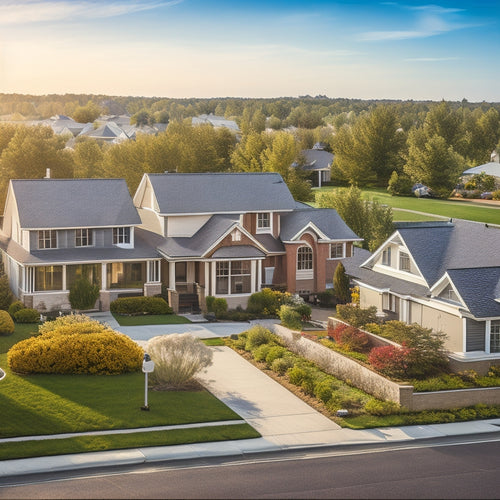
What Makes a Road Bike-Friendly by Design?
Share
As you plan and design roads, incorporating features like dedicated bike lanes, smooth surfaces, and traffic calming measures can greatly enhance cycling safety and comfort. Wide bike lanes with buffers, regular surface maintenance, and speed limit enforcement all contribute to a bike-friendly road. Additionally, designing safer intersections, cycling corridors, and green infrastructure can minimize conflicts and make cycling a viable option. By prioritizing these design elements, you'll create a safer and more enjoyable cycling experience. And that's just the beginning - there's more to explore when it comes to crafting a truly bike-friendly road.
Key Takeaways
• Bike lanes should be at least 3.5 meters wide with buffer zones for flexibility, safety, and comfort.
• Smooth road surfaces with regular maintenance reduce accidents and encourage cycling.
• Traffic calming measures and speed limit enforcement promote a safer road culture for cyclists.
• Well-designed road geometry, visibility, and drainage ensure safety and visibility for cyclists.
• Smart lighting, reflective markings, and solar-powered systems improve nighttime visibility and safety.
Bike Lane Width and Buffering
When designing road bike-friendly infrastructure, you'll want to make sure bike lanes are at least 3.5 meters wide to accommodate safe passing distances and provide a comfortable riding experience. This width allows for lane flexibility, enabling cyclists to ride side by side or overtake each other safely. A wider lane also reduces the likelihood of accidents caused by cyclists swerving to avoid obstacles or debris.
Additionally, incorporating a buffer zone between the bike lane and the road can greatly enhance safety. This zone can be marked with painted lines, bollards, or other physical separators to prevent motor vehicles from entering the bike lane. The buffer zone also provides an added layer of protection for cyclists, giving them a sense of security and comfort while riding.
Surface Quality and Maintenance
By ensuring bike lanes have a smooth, even surface, you can reduce the risk of accidents caused by potholes, cracks, and other hazards that can throw cyclists off balance. A well-maintained surface is essential for a bike-friendly road design. Regular maintenance scheduling and repair prioritization are vital to prevent potholes from forming in the first place. Crack sealing and pothole repair should be done promptly to prevent further damage.
| Pavement Condition | Maintenance Action | Frequency |
|---|---|---|
| Good | Regular inspection | Quarterly |
| Fair | Crack sealing, pothole repair | Bi-annually |
| Poor | Resurfacing, rehabilitation | Annually |
A smooth surface texture is also critical, as it affects the comfort and safety of cyclists. By prioritizing surface quality and maintenance, you can create a bike-friendly road design that encourages cycling and reduces the risk of accidents. Remember, a well-maintained surface is not only safer but also more comfortable for cyclists, making it an essential aspect of bike-friendly road design.
Traffic Calming and Speed Limits
As you design bike-friendly roads, you'll need to think about how to slow traffic down safely, ensuring that drivers aren't posing a threat to cyclists.
Enforcing speed limits effectively is essential, and you can achieve this through a combination of traffic calming measures and clever lane design.
Slowing Traffic Down Safely
To guarantee cyclists' safety, you'll want to slow traffic down to a crawl, and that means implementing effective traffic calming measures and enforcing reasonable speed limits. By doing so, you'll create an environment where cyclists can ride comfortably, without the constant fear of speeding vehicles.
One effective way to slow traffic down is by incorporating traffic circles, also known as roundabouts. These circular intersections force drivers to slow down and navigate through the circle, reducing their speed and increasing their awareness of their surroundings.
Additionally, speed tables, or raised crosswalks, can be used to slow traffic down. These speed-reducing measures encourage drivers to slow down and be more mindful of pedestrians and cyclists.
Enforcing Speed Limits Effectively
You need to make sure that speed limit enforcement is an integral part of your traffic calming strategy, as it's equally important to have measures in place to prevent drivers from exceeding safe speeds. This can be achieved through a combination of technology and community engagement.
| Enforcement Method | Effectiveness |
|---|---|
| Speed cameras | High, with 80% reduction in speeding |
| License tracking | Medium, with 40% reduction in speeding |
| Community policing | Low, with 20% reduction in speeding |
| Public awareness campaigns | Low, with 10% reduction in speeding |
Designing Narrower Lanes
Designing narrower lanes effectively reduces vehicle speeds, as drivers instinctively slow down when road width decreases. This clever design approach not only calms traffic but also makes roads more bike-friendly. By narrowing lanes, you're encouraging drivers to adopt a more cautious and attentive approach, which in turn creates a safer environment for cyclists.
Lane reallocation is a key aspect of designing narrower lanes. By reallocating excess lane width, you can create dedicated bike lanes, improving safety and promoting a culture of mutual respect between drivers and cyclists. This flexibility in lane design allows for a more efficient use of road space, catering to the needs of multiple users.
Narrower lanes also promote lane flexibility, enabling drivers to adapt their speed and behavior according to the road conditions. This flexibility is essential in creating a harmonious coexistence between drivers and cyclists. By embracing narrower lanes, you're not only reducing speeds but also fostering a more considerate and sharing road culture.
Intersections and Turning Radii
As you design bike-friendly roads, you'll need to take into account how intersections and turning radii impact cyclists' safety and comfort.
You'll want to make sure that turning radii are wide enough to accommodate comfortable turns, and that curb radii are designed to prevent sharp angles and tight turns.
Tight Turning Radii
As a road bike rider, you know that maneuvering tight turns is an essential part of your ride. Road bike riders often need to maneuver tight turns, which is why intersections and turning radii must be designed with a minimum radius of 20-30 feet to guarantee safe and comfortable passage. This allows you to maintain control and balance while cornering, reducing the risk of accidents or falls.
When you're approaching a tight turn, your cornering techniques come into play. You'll need to adjust your speed and body position to make sure a smooth turn. A well-designed turning radius enables you to maintain a comfortable turning speed, which is important for maintaining control and balance.
If the turning radius is too tight, you'll need to slow down significantly, which can be frustrating and impact your overall ride experience. By designing roads with adequate turning radii, you can enjoy a safer and more enjoyable ride, allowing you to focus on your technique and the road ahead.
Safe Turning Angles
When maneuvering through tight intersections, you'll appreciate road bike-friendly designs that incorporate safe turning angles, allowing you to execute smooth, controlled turns without sacrificing speed or stability.
Optimizing turning angles is vital for road bike safety. A well-designed intersection should provide ample visibility for cyclists, enabling them to anticipate and respond to potential hazards. This can be achieved by implementing the following design principles:
| Design Element | Recommended Specification |
|---|---|
| Turning radius | Minimum 10m to guarantee smooth turns |
| Intersection angle | 90-degree angles or slightly rounded to reduce conflict points |
| Visibility | Clear sightlines for cyclists and motorists to anticipate each other's movements |
Wide Curb Radii
Maneuvering wide curb radii at intersections can greatly impact your safety and comfort as a cyclist, allowing you to maintain speed and control while making turns. When you're negotiating a turn, a wider curb radius means you can take the turn more smoothly, with less risk of losing control or falling. This is especially important for cyclists, who often have to contend with heavy traffic, poor road surfaces, and other hazards.
In bike-friendly cities, you'll often see wide curb radii at intersections, particularly in areas like urban plazas and pedestrian zones. These designs prioritize cyclist safety and comfort, recognizing that a smooth, flowing ride is essential for a pleasant and stress-free experience.
Conflict Zone Mitigation Strategies
Conflict Zone Mitigation Strategies
Your route planning should prioritize avoiding conflict zones, where motorist and cyclist interactions are most prone to escalate into accidents or aggressive behavior. Land use planning plays an important role in minimizing these zones. By designing bike-friendly roads, you can reduce the likelihood of conflicts between motorists and cyclists.
Here are some strategies to mitigate conflict zones:
| Land Use Strategy | Conflict Resolution |
|---|---|
| Mixed-use development | Reduces traffic volume, promoting cyclist safety |
| Pedestrian-friendly zones | Decreases motorist speed, creating a safer cycling environment |
| Bike lanes with buffers | Provides a physical barrier between cyclists and motorists |
| Restricted parking areas | Reduces traffic congestion, minimizing cyclist-motorist interactions |
| Green infrastructure | Calms traffic, creating a more peaceful cycling experience |
Cycling Network Connectivity
By linking bike-friendly roads, bike paths, and pedestrianized areas, you can create a seamless cycling network that lets you ride safely and efficiently across the city. This connectivity is key to making cycling a viable transportation option. When you can easily switch between different types of infrastructure, you're more likely to choose your bike over a car.
Here are three ways to visualize a well-connected cycling network:
-
Cycling corridors: Imagine dedicated bike lanes that stretch for miles, connecting residential areas to commercial hubs.
-
Route flexibility: Picture having multiple routes to choose from, allowing you to adjust your journey based on traffic, roadwork, or personal preference.
-
Smooth handovers: Envision effortlessly changing between bike paths, bike lanes, and pedestrianized zones, without ever having to navigate busy roads or confusing intersections.
Road Geometry and Visibility
As you ride through the city, you'll navigate roads with varying geometries, from sweeping curves to tight intersections, and it's the essential design of these road features that guarantees your safety and visibility.
The road's alignment plays a vital role in ensuring you're visible to motorists, pedestrians, and other cyclists. A well-designed road geometry provides ample corner visibility, allowing you to anticipate and prepare for turns, reducing the risk of accidents.
Tight corners with poor visibility can be hazardous, but a bike-friendly design incorporates features like rounded corners, gentle curves, and ample signage to guide you through the route. Additionally, the road's alignment affects your line of sight, influencing your ability to detect potential hazards and react accordingly.
Bicycle-Friendly Drainage Systems
You'll appreciate a well-designed drainage system that quickly disperses water, reducing the risk of hydroplaning and ensuring a smoother ride on wet roads.
A well-planned drainage system is crucial for a bike-friendly road, as it prevents water accumulation and guarantees a safer ride.
When it comes to drainage design, consider the following key elements:
-
Grate design: Slotted grates allow water to drain quickly, reducing the risk of hydroplaning. Look for grates with narrow slots that allow water to flow through while keeping debris out.
-
Drainage material: Permeable materials like porous asphalt or concrete allow water to drain through, reducing surface water accumulation. These materials are ideal for bike lanes and roads.
-
Drain placement: Ensure that drains are strategically placed to capture water runoff, especially at curbs, gutters, and intersections where water tends to accumulate.
Lighting and Nighttime Visibility
When cycling at night, sufficient lighting is essential for your safety, and a well-designed lighting system can make all the difference between a comfortable ride and a hazardous one. As you ride through the dark, you want to be visible to motorists and pedestrians, and you want to see the road ahead clearly.
To achieve this, cities are incorporating innovative lighting solutions into their bike-friendly designs. Here are some examples:
| Lighting Solution | Description | Benefits |
|---|---|---|
| Smart Lighting | Adaptive lighting that adjusts brightness based on natural light availability | Energy efficiency, improved visibility |
| Reflective Pavement | Pavement markings with reflective materials | Increased visibility, reduced maintenance |
| LED Lighting | Energy-efficient LED lights along bike lanes | Improved visibility, reduced energy consumption |
| Solar-Powered Lighting | Solar-powered lights along bike paths | Renewable energy, reduced carbon footprint |
| Motion-Sensing Lighting | Lights that turn on when a cyclist approaches | Increased safety, reduced energy consumption |
Frequently Asked Questions
How Do Bike-Friendly Roads Impact Local Business and Economy?
"Don't you wonder how many local businesses could thrive with bike-friendly roads? As you invest in bike-friendly infrastructure, you're not only boosting local investment, but also sparking economic growth, making your community a more attractive, livable hub."
Can Road Bike-Friendliness Be Achieved Without Dedicated Bike Lanes?
You can achieve road bike-friendliness without dedicated lanes by implementing traffic calming measures and optimizing road geometry, such as narrower lanes and chicanes, to reduce speeds and prioritize cyclist safety.
Do Bike-Friendly Roads Always Prioritize Cyclists Over Motorists?
You've likely encountered roads where cyclists seemingly rule the road, leaving motorists fuming - but let's be real, bike-friendly roads don't always prioritize cyclists over motorists; it's about balance, not cyclist entitlement or motorist frustration.
Are Bike-Friendly Roads Only Suitable for Urban Areas or Rural Too?
You might think bike-friendly roads are only for urban areas, but they can also enhance rural connectivity by improving road accessibility, making cycling a viable option for rural commuters and tourists alike.
How Do Weather Conditions Affect Bike-Friendly Road Design?
"When you're designing bike-friendly roads, you're not just building for sunny days - you're bracing for impact, like a rainy surface that's as slick as a snake's belly, or snowy roads that'll leave you slipping and sliding."
Related Posts
-

Waterproofing Solar Panels for Vehicles: A Step-by-Step Guide
When waterproofing solar panels for your vehicle, start by evaluating your energy requirements and selecting the righ...
-

Top Online Stores for Solar Car Accessories
When searching online for solar car accessories, you'll find top retailers like Amazon, REI Co-op, and Best Buy offer...
-

Why Invest in Residential Solar Panel Systems?
By investing in a residential solar panel system, you'll harness renewable energy, reducing your carbon footprint and...


